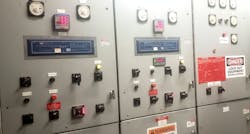CHP Microgrid Can Serve Needs of 26,000 at College When Grid is Down
A combined heat and power (CHP) microgrid operated by Veolia can supply 100% of the power needed for the 26,000 people at Saddleback College in Mission Viejo, California, switching into island mode automatically when the grid is down.
The CHP microgrid, which has been operating for six years, is an example of how colleges and other organizations can weather California’s public safety power shut offs and outages due to the increased incidence of fire, said Jack Griffin, vice president and general manager at Sourceone, a division of Veolia.
“Microgrids, which offer communities and institutions an independent power source, are transforming the way municipalities adapt to severe weather and electricity shortages in many states,” he said.
The CHP microgrid is connected to San Diego Gas & Electric’s (SDG&E) main grid, drawing only a small amount of power — 100 kW, explained Paul Savage, vice president of operations, municipal & commercial business for Veolia
The microgrid includes two natural gas generators that together are rated at 1.5 MW.
Program logic senses loss of utility power
“If the grid goes down, in island mode the microgrid can still power 100% of the campus,” he said. “This provides assurances that classes and other functions can continue.”
A program logic controller automatically switches the microgrid into island mode when there’s an outage.
“When SDG&E power goes off, the breaker supplying the plant trips open, and the program logic senses the loss of SDG&E power, increasing fuel to the generators to make up for the load that was being carried by SDG&E,” Savage said.
When the microgrid is not in island mode, the program logic controller responds to the college’s electric demand, providing more power from the CHP plant when demand increases while drawing only 100 kW from SDG&E .
“The supply from SDG&E remains constant at 100 kW,” said Savage.
When power from SDG&E is restored after an outage, an operator manually re-connects the plant to the utility.
“The program logic senses power being supplied by SDG&E and reduces fuel to the generators to establish the 100 kW supplied by SDG&E,” he said.
CHP microgrid provides ‘green steam’
The CHP plant is more efficient than relying on utility power because waste heat from the generators is used in a hot water loop that provides both heating and air conditioning.
“The campus has been able to eliminate individual air conditioning units in each building because there’s a chilled water loop that goes through campus,” Savage said.
Also eliminated were hot water heaters because the hot water loop heated with waste heat provides hot water.
The waste heat produces “green steam,” he said.
“Instead of burning coal to fire a boiler or burning more electricity to run a hot water heater, the plant captures and uses waste heat from the generators,” he said.
The college doesn’t provide any grid services or feed any power to the grid, Savage noted.
Other Veolia microgrids
In addition to the microgrid at Saddleback College, Veolia operates some diesel microgrids that power municipal wastewater treatment plants in California. Some of these have been affected by public safety power shutoffs in Southern California Edison’s (SCE) territory — prompted by the possibility of utility electrical equipment sparking fires.
These diesel microgrids serve the important role of preventing wastewater from backing up and overflowing, Savage noted. They also power pumps that transport water to fire hydrants.
Like the college microgrid, the diesel microgrids automatically island from SCE when there’s a power outage.
“They sense the loss of line voltage and automatically start and we have vital loads that are automatically picked up,” he said.
Move toward cleaner resources
The municipalities Savage works with have expressed interest in finding cleaner sources of power for the microgrids.
“There may be a better solution out there; we are working with our cities and municipalities to figure out if there is a better solution for their communities as we get into the new normal of power outages in California,” Savage said.
He expects to see increasing numbers of public safety power shut offs — and the installation of more microgrids to protect people from the effects of power outages.
“The (public safety power shutoff) strategy increases the value of distributed energy resource-powered microgrids.” said Griffin.
Read about more CHP microgrid projects here on Microgrid Knowledge.
About the Author
Lisa Cohn
Contributing Editor
I focus on the West Coast and Midwest. Email me at [email protected]
I’ve been writing about energy for more than 20 years, and my stories have appeared in EnergyBiz, SNL Financial, Mother Earth News, Natural Home Magazine, Horizon Air Magazine, Oregon Business, Open Spaces, the Portland Tribune, The Oregonian, Renewable Energy World, Windpower Monthly and other publications. I’m also a former stringer for the Platts/McGraw-Hill energy publications. I began my career covering energy and environment for The Cape Cod Times, where Elisa Wood also was a reporter. I’ve received numerous writing awards from national, regional and local organizations, including Pacific Northwest Writers Association, Willamette Writers, Associated Oregon Industries, and the Voice of Youth Advocates. I first became interested in energy as a student at Wesleyan University, Middletown, Connecticut, where I helped design and build a solar house.
Twitter: @LisaECohn
Linkedin: LisaEllenCohn
Facebook: Energy Efficiency Markets

